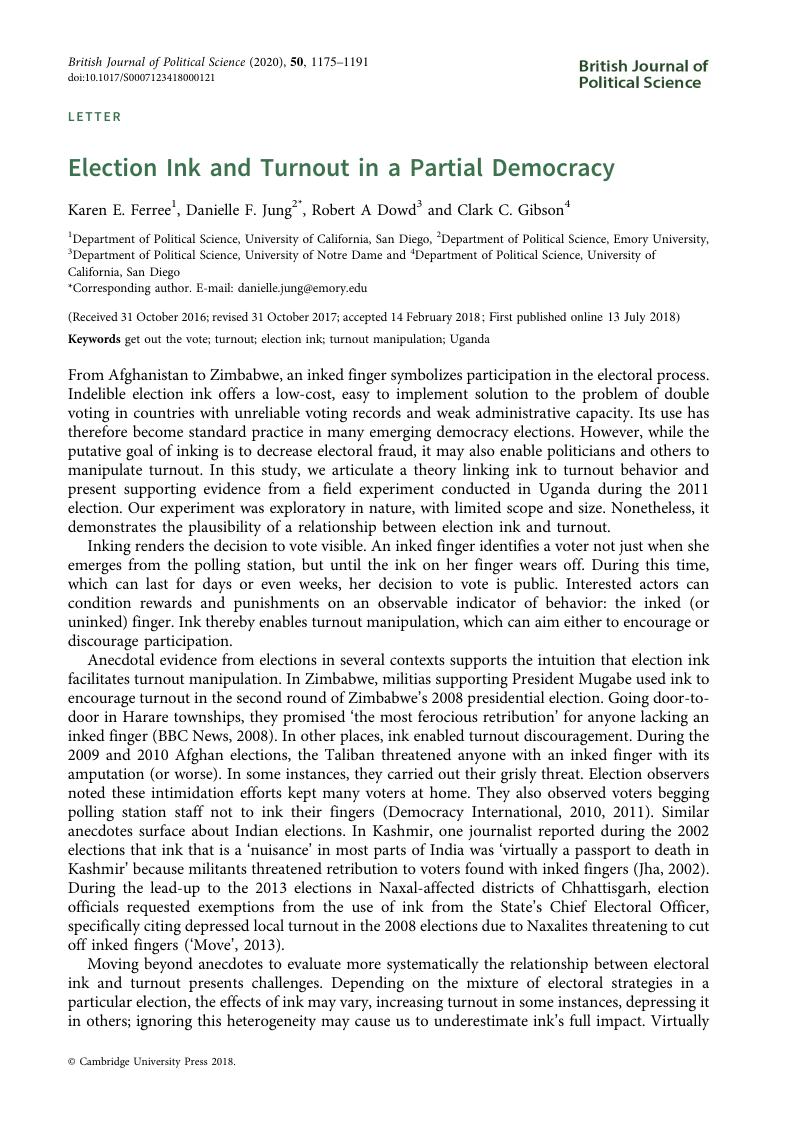Crossref Citations
This article has been cited by the following publications. This list is generated based on data provided by Crossref.
Carlson, Elizabeth
2020.
Field Experiments and Behavioral Theories: Science and Ethics.
PS: Political Science & Politics,
Vol. 53,
Issue. 1,
p.
89.
Ferree, Karen E.
Jung, Danielle F.
Dowd, Robert A.
and
Gibson, Clark C.
2020.
Election Ink and Turnout in a Partial Democracy.
British Journal of Political Science,
Vol. 50,
Issue. 3,
p.
1175.
Harris, J. Andrew
2021.
Election Administration, Resource Allocation, and Turnout: Evidence From Kenya.
Comparative Political Studies,
Vol. 54,
Issue. 3-4,
p.
623.
Harris, J. Andrew
Kamindo, Catherine
and
van der Windt, Peter
2021.
Electoral Administration in Fledgling Democracies: Experimental Evidence from Kenya.
The Journal of Politics,
Vol. 83,
Issue. 3,
p.
947.
Bohn, Frank
and
Wang, Xue
2022.
Rational erraticism.
Journal of Theoretical Politics,
Vol. 34,
Issue. 2,
p.
219.
Cammett, Melani
Kruszewska-Eduardo, Dominika
Parreira, Christiana
and
Atallah, Sami
2022.
Coethnicity Beyond Clientelism: Insights from an Experimental Study of Political Behavior in Lebanon.
Politics and Religion,
Vol. 15,
Issue. 2,
p.
417.
Jung, Danielle F.
and
Long, James D.
2023.
The Social Origins of Electoral Participation in Emerging Democracies.
CHEEMA, ALI
KHAN, SARAH
LIAQAT, ASAD
and
MOHMAND, SHANDANA KHAN
2023.
Canvassing the Gatekeepers: A Field Experiment to Increase Women Voters’ Turnout in Pakistan.
American Political Science Review,
Vol. 117,
Issue. 1,
p.
1.
Allie, Feyaad
2023.
Facial Recognition Technology and Voter Turnout.
The Journal of Politics,
Vol. 85,
Issue. 1,
p.
328.
Ahmed, Firoz
Hodler, Roland
and
Islam, Asad
2024.
Partisan Effects of Information Campaigns in Competitive Authoritarian Elections: Evidence from Bangladesh.
The Economic Journal,
Vol. 134,
Issue. 660,
p.
1303.
Jamroga, Wojciech
Roenne, Peter B.
Kim, Yan
and
Ryan, Peter Y. A.
2025.
Financial Cryptography and Data Security. FC 2024 International Workshops.
Vol. 14746,
Issue. ,
p.
66.


